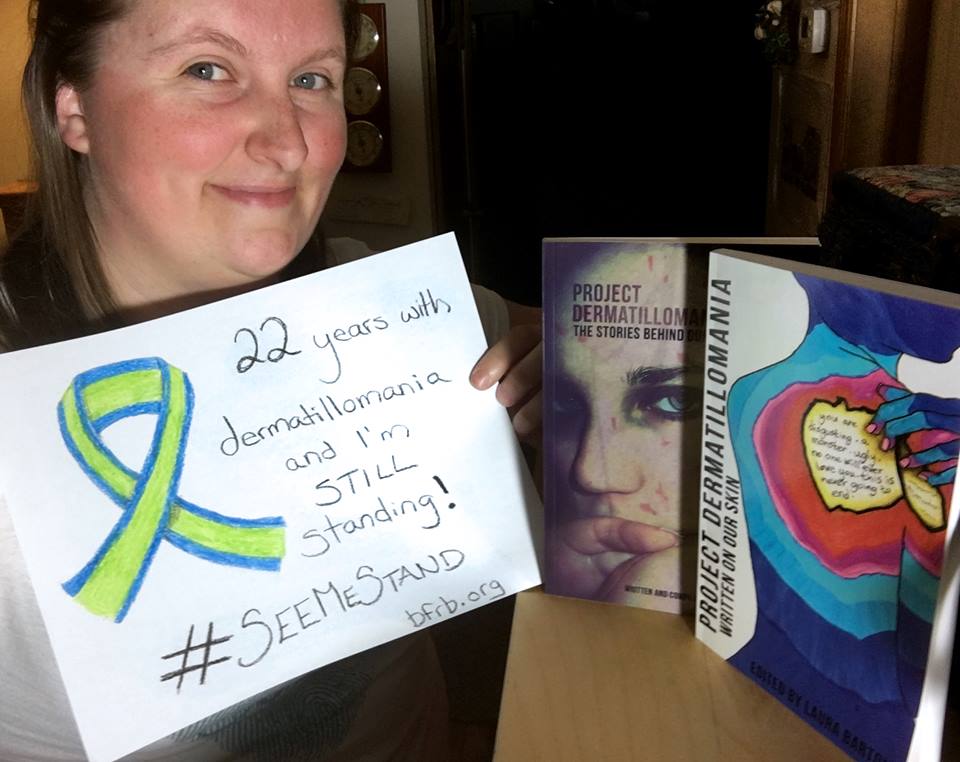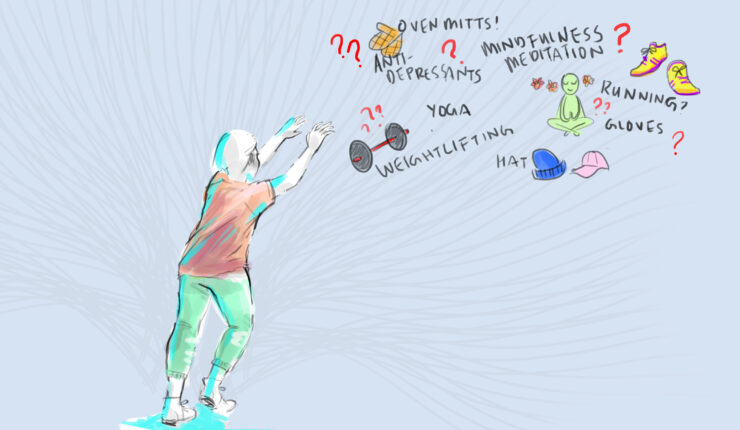Broadening mental illness initiatives means recognizing, accepting BFRBs
Mental health is becoming an increasingly prevalent topic, particularly on Canadian post-secondary campuses. The University of Ottawa has recently developed a Standing Committee on Student Wellbeing, which seeks to increase the university’s understanding of complex mental health needs and bridge the gap between necessary services and the needs of the student population.
Large-scale anti-stigma campaigns like Bell Let’s Talk, which takes place each year near the end of January, encourages people to “spread the word” about mental health. Many use this opportunity to share their lived experiences of mental illness on social media.
This move towards a more open discussion of mental illness at both the university and on social media is inarguably positive, but not all mental illnesses are treated equally in anti-stigma activism. Mental illnesses are often referred to as “invisible illnesses” and anti-stigma discourse often revolves around the idea of making the invisible visible. By talking about mental health, we hope to bring people’s feelings to the surface.
Yet for myself, and approximately 1 million other Canadians, our mental illness manifests itself on the surface already. We quite literally wear our illness on our sleeve—or rather, our skin.
An illness overlooked in mental health discourse
As I write this article, I am making my skin bleed in the space where my right eyebrow should be, trying to pull at hair that isn’t there. I am fully aware that this is happening. I don’t want it to be happening, and I beg myself to stop but my hand moves of its own volition. I feel like a puppet—my disorder is the puppet master.
Years of living with my condition have resulted in severe hair loss and dark purple scarring all over my body. I haven’t had eyebrows since 2015.
In 2014, I was diagnosed with trichotillomania (compulsive hair pulling) and dermatillomania (compulsive skin picking). These illnesses are Body Focused Repetitive Behaviours (BFRBs), which are classified as Obsessive Compulsive Related Disorders in the Diagnostic and Statistical Manual of Mental Disorders-V (DSM-5), the most recent publication of the text.
There is some controversy among researchers as to the actual nature of these conditions, and many argue that there are enough distinctive differences between BFRBs and obsessive compulsive disorders to grant their separation. BFRBs are characterized by an overwhelming urge to self-groom, or fix bodily imperfections.
Common BFRBs (Source: Canadian BFRB Support Network)
| Trichotillomania | The compulsive urge to pull out hair from various parts of the body resulting in noticeable hair loss. Areas where pulling usually occur include scalp, eyelashes, eyebrows, arms, legs, and pubic area. |
| Dermatillomania | The compulsive urge to pick at one’s skin resulting in noticeable damage (sores, scabs, infections). Common areas include face, head, cuticles, back, arms and legs, hands and feet. |
| Trichophagia | Coinciding with trichotillomania, trichophagia is the compulsive urge to eat or ingest the hair that has been pulled. In extreme cases, this can lead to a hair ball called a trichobezoar, which can cause significant health problems. Removal of the hair ball is usually done through surgery. |
| Dermatophagia | Compulsive skin biting around areas such as the nails, lips, and inside of cheeks. |
| Trichotemnomania | Compulsive hair cutting or shaving |
| Onychophagia |
Compulsive nail biting. The severity and extent of damage to the skin is variable, but can lead to infections, pain in the fingers and torn skin around the fingernails. Some signs include short nails, skin damage around nails, bleeding skin around nails, callouses. |
Some people believe these illnesses are simply bad habits that can be controlled, if only the person could exhibit just a little more “willpower” or “self-control.” Anyone with a BFRB will tell you that their illness is anything but a choice and that recovery has nothing to do with willpower.
Learning to live with an illness that is highly under-researched and greatly misunderstood is a full-time job. Add a full-time graduate level course load, two part-time jobs, and a thesis, and you have but a small glimpse into the chaos that is my life.
I frequently have to navigate unwanted conversations about my “strange” appearance with internet trolls, hair dressers, new friends, professors, doctors, and family members. It’s time that we changed the conversations about mental illness to include BFRBs. Thankfully, there is an incredible network of activists doing just that.
Changing the conversation
Oct. 7 marked the end of BFRB Awareness Week which, donning the theme #SeeMeStand, is dedicated to educating the public about these disorders and helping contribute to the elimination of stigma. Members of the BFRB community have come together in a social media campaign to prove that BFRBs are common disorders affecting millions of people, and that those who suffer are not alone.
https://www.instagram.com/p/BLBdTtVAVulMqYd2e0_jVTP1LYoo5cAWAjoTWQ0/
My Doctor Had to Google My Disorder (or “Why Having #Trichotillomania Sucks”) https://t.co/v937fqhK4Z #BFRBAwarenessWeek #SeeMeStand
— jess 🌻 (@jessicagallen_) October 2, 2017
Happy #BFRBWeek! #SeeMeStand #EndTheStigma #Trichotillomania pic.twitter.com/uHU9upTrhs
— molly (@mollycatee) October 4, 2017
@tlcBFRB this is my best friend @AllTimeL0ser31 (Rachel) and she never judges if I am missing hair or eyebrows #SeeMeStand pic.twitter.com/PmXSCs2Xrb
— DxE Carol💚-ALF (@dxe_carol9) August 28, 2017
This broad outreach is largely in response to myths that BFRBs affect a small percentage of our population, justifying the limited amount of research on the causes and treatments for these disorders. Current numbers place the amount of people with one or more BFRBs at approximately 2-4 per cent of the population.
Comparatively, approximately 1.5 per cent of Canadians are diagnosed with bipolar disorder, 4.7 per cent have been diagnosed with depression, and 12 per cent with anxiety. Despite the comparative prevalence of BFRBs to depression, one of the most commonly known mental illnesses in the world, little is known about what causes them or how to treat them.
According to the Canadian BFRB Support Network, there are only eight doctors in Canada that specialize in treating BFRBs. Most doctors aren’t even aware that they exist.
My own experience with medical professionals has varied. For the past three years, I have been seen by countless doctors and two different psychiatrists. I am on my fourth therapist.
I have been prescribed various antidepressants in increasingly higher doses. For a while, I was prescribed the maximum dose of highly addictive anti-anxiety medications, and at one point, I was even tried on antipsychotics. I have been a guinea pig in my own treatment because there are no available treatment plans that actually work.
Different doctors have different approaches, and because I am desperate, I try them. I have tried mindfulness meditation, running, kickboxing, weightlifting, and yes, yoga. I have worn hats, headbands, gloves, oven mitts, anything to cover my hair, skin, or my worst enemy, my own hands. Band-Aids are one of my biggest expenses along with antibiotic ointment to control infections.
I am not the only person who has struggled with doctors, or navigating my BFRBs in general.
BFRB activist Laura Barton, who lives with dermatillomania and dermatophagia, says that her “BFRB brain” kicks in when she feels “a rough patch of skin or a bump or something that doesn’t seem to ‘belong’.”
Barton says that the hardest part about having BFRBs is dealing with the misinformation and misconceptions that dominate the discussion.
“People outside the BFRB community, and unfortunately even many inside the community, continue to think BFRBs are just habits or attention-seeking, for instance.”
Angela Hartlin is the author of FOREVER MARKED: A Dermatillomania Diary and the star of the documentary Scars of Shame. Hartlin lives with dermatillomania and trichotemnomania, and says that for her the behaviours involved in her disorders are cathartic, but being unable to stop the behaviour on command is the most frustrating element of living with BFRBs.
“It’s knowing that what you’re doing is not ‘fixing’ the issue, like the mind tries to justify, but being unable to adhere to that logic.”
Navigating post-secondary life with BFRBs
With little research and recognition around BFRBs, it might not be surprising that the U of O has limited resources when it comes to helping students cope.
Barton recalls that her time at university, while dealing with her BFRBs, was so difficult it led her to want to end her life.
“I was still desperately looking for a cure or a way to stop,” she says, “and since that wasn’t available, I felt helpless and weak. I felt like a failure because I couldn’t just stop this behaviour like everyone wanted me to.”
Hartlin recalls essay writing as being particularly tough to balance with the anxiety caused by her BFRBs.
“My anxiety was so high that I would take breaks in between writing to go pick. An essay that would take someone else eight hours to complete would take me at least 14 (approximately) when you count the breaks to pick.”
Barton later attended college, and while she had a more positive experience with her mental health, she still found that there were no resources for those living with BFRBs.
At the U of O it isn’t much different—the go-to mental health resource for students is the Student Academic Success Service’s (SASS) Counselling and Coaching Service. When asked if they offer services for BFRBs over email, a representative said that no counsellors are specialized in that area but that they could help with anxiety.
The representative also suggested checking for a psychologist at the U of O’s Centre for Psychological Services and Research (CPSR). When asked by the Fulcrum if they are able to treat BFRBs, a representative from CPSR said that although they have treated patients for these disorders in past they do not specialize in this treatment.
As far as academic accommodations go, Access Service was unable to comment on BFRBs specifically, but told the Fulcrum over email that they “can assess and as well, provide accommodations/recommendations for any student with a diagnosed and duly documented medical condition.”
Coping outside of the margins
In our interview, Hartlin told me that despite being an open mental health advocate, she was once kicked out of therapy because she had questioned the therapist.
There is a clear lack of understanding when it comes to BFRBs that leak into the formal channels that people with mental illnesses are told to turn to. With these avenues failing people, at post-secondary school and beyond, many living with these disorders learn to seek help elsewhere.
Online support groups can serve as a community, providing a place of understanding, acceptance, and refuge for people who live with BFRBs. One of many groups available to people looking to find such a community is the Canadian BFRB Support Network.
Acceptance is a key coping method for Barton, but for her going hand in hand with that is information.
“It’s probably not an answer that anyone expects, but honestly, understanding that these are disorders helps me deal with them better because I know what I’m up against, which is where information plays in. The more I learn about BFRBs, the better I understand them.”

Barton holds up her #SeeMeStand sign in honour of BFRB awareness week.
Recognizing our biases, acting to change them
Although BFRB Awareness Week may be over, if we want to make post-secondary life more accessible to people with these disorders, we cannot wait until next year to continue the discussion.
“BFRB Week, to me, means a chance for the community to come together to learn, support each other, and educate others on a large scale,” says Barton.
“Life with BFRBs isn’t easy, but it doesn’t have to be the end of us, either,” she emphasized. “It takes time and a lot of changing to our mindsets in many cases, but it is 100 per cent possible to live a happy and full life with whether the BFRB ever goes away or not.”
Mental health campaigns can be a good way to spread awareness, but when they are silent on certain disorders this speaks volumes, and trickles into the way institutions handle mental illness—as seen from the near complete lack of services for U of O students living with BFRBs.
Going forward in our discussion of BFRBs, Hartlin wants people to know that “BFRBs are not fun, trendy, or a new-age type of disorder.”
“While skin picking didn’t become official until May of 2013 when it was entered into the DSM 5 as ‘Excoriation Disorder,’ there is documentation of patients as early as the 1800s having this issue. It is very real.”
And although we might like to think we’re beyond the point of people with mental illnesses having to say that what they experience is “real,” this clearly isn’t the case.
If you or someone you know needs help coping with their BFRB, there are several ways to reach out and ask for help. If you are a post-secondary student in crisis, you can speak to a crisis counsellor for free in Ontario through Good2Talk at 1-866-925-5454. Join the “Jack.org – University of Ottawa” Facebook page to receive updates for peer-to-peer mental health support and anti-stigma campaigns.





